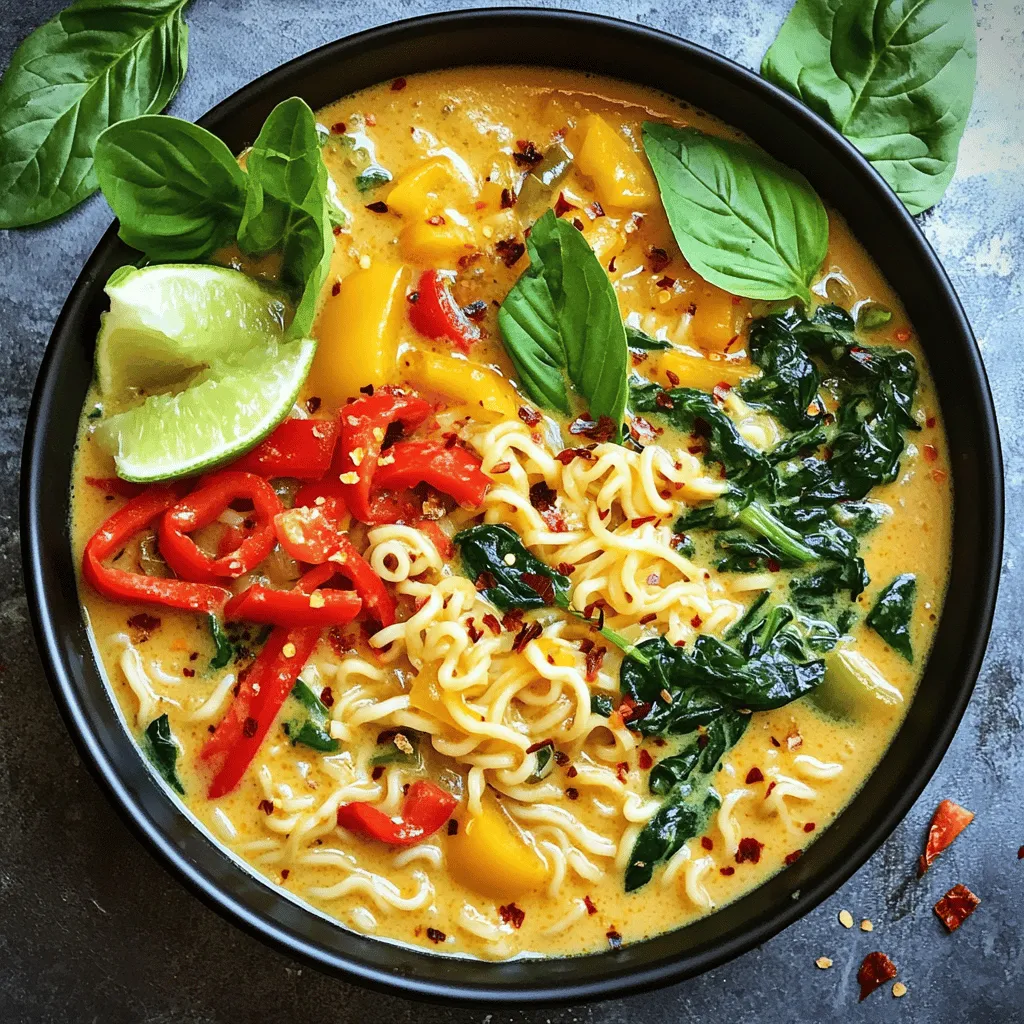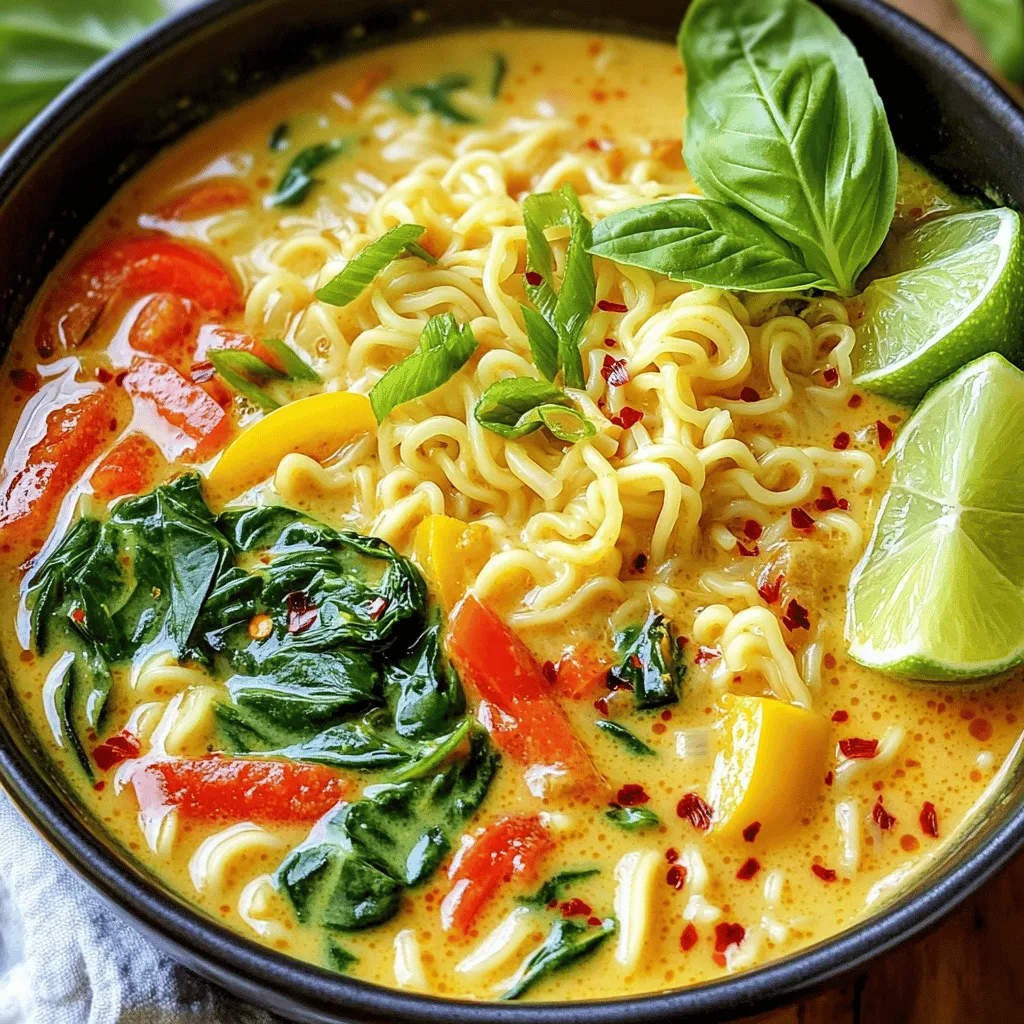Are you ready for a delicious twist on ramen? This Thai Coconut Curry Ramen is rich, creamy, and packed with flavor. You can make it in just a few simple steps, and it’s perfect for any meal. Whether you want to customize it or keep it classic, I have tips to help. Join me as we dive into this easy recipe that will wow your taste buds!
Ingredients
List of Ingredients
– 2 packs of fresh ramen noodles
– 1 can (400ml) full-fat coconut milk
– 2 cups vegetable broth
– 2 tablespoons red curry paste
– 1 tablespoon soy sauce
– 1 tablespoon lime juice
– 1 teaspoon brown sugar
– 1 cup bell peppers, sliced
– 1 cup baby spinach leaves
– 1 cup mushrooms, sliced
– 1 can (15 oz) chickpeas, rinsed
– Fresh basil leaves for garnish
– Lime wedges for serving
– Optional: chili flakes or fresh chili
Recommended Brands
For the best flavors, I recommend using Thai Kitchen for red curry paste and Native Forest for coconut milk. Both brands provide rich flavors that enhance your dish. For soy sauce, Kikkoman offers a great choice, or go for Tamari if you need a gluten-free option.
Optional Ingredients for Customization
You can customize your ramen in many ways. Try adding tofu for protein or zucchini for extra veggies. For a unique twist, consider adding a splash of fish sauce or a dash of sesame oil. If you’re a spice lover, fresh chilies or sriracha can really amplify the heat in your bowl.
Step-by-Step Instructions
Preparing the Broth
Start by taking a large saucepan. Heat it over medium heat. Pour in one can of full-fat coconut milk and two cups of vegetable broth. Whisk them together gently until they mix well. Bring the mixture to a gentle simmer. This step is key. The warm broth will help release the flavors as you add more ingredients.
Next, add two tablespoons of red curry paste. You can adjust this based on your spice preference. Then, stir in one tablespoon of soy sauce and one tablespoon of freshly squeezed lime juice. Don’t forget to add one teaspoon of brown sugar. This will balance the heat from the curry paste. Keep stirring until everything is smooth and fragrant.
Cooking the Vegetables
Once your broth is ready, add one cup of thinly sliced bell peppers. A mix of red and yellow adds color and taste. Then, toss in one cup of sliced mushrooms. Shiitake or button mushrooms work best. Let the mixture simmer for about five minutes. This will soften the veggies and meld the flavors beautifully.
After five minutes, add one can of drained and rinsed chickpeas. Stir well to combine. Let it cook for three more minutes. This will heat the chickpeas and let them soak up the broth’s tasty flavors.
Lastly, stir in one cup of rinsed baby spinach leaves. Allow them to wilt for about one to two minutes. This adds a fresh touch to your dish.
Cooking the Ramen Noodles
While your broth is simmering, prepare the ramen noodles. Cook them according to the package instructions. This usually takes just a few minutes. Once cooked, drain the noodles and set them aside.
Now, it’s time to serve! Place a generous amount of cooked ramen noodles in each bowl. Ladle the aromatic coconut curry broth over the noodles. Make sure to include the vibrant vegetables and chickpeas.
Finish each bowl with fresh basil leaves for garnish. Serve hot, with lime wedges on the side. If you want extra heat, add chili flakes or sliced fresh chili. Enjoy your tasty Thai coconut curry ramen!
Tips & Tricks
Adjusting Spice Levels
To adjust spice levels, start with less red curry paste. You can use 1 tablespoon if you prefer mild flavors. Taste the broth after adding the paste. If you want more heat, add more paste or chili flakes. Remember, you can always add more, but it’s hard to take away.
Making it Vegan or Gluten-Free
This recipe is almost vegan. Just use soy sauce or tamari for gluten-free. For a vegan option, ensure your red curry paste has no fish sauce. Most brands make vegan options. You can also swap chickpeas with tofu for extra protein. Tofu will soak up flavors well.
Enhancing Flavor Profiles
To boost flavor, add fresh herbs like cilantro or basil. These bring brightness to the dish. A splash of lime juice before serving adds a fresh zing. You can also experiment with spices like ginger or garlic. They add depth and warmth to the overall taste.

Variations
Protein Additions
You can add protein to your Thai coconut curry ramen for a heartier meal. Here are some options:
– Chicken: Slice cooked chicken breast and add it to the broth. Use rotisserie chicken for quick prep.
– Shrimp: Add peeled shrimp during the last few minutes of cooking. They cook quickly and add great flavor.
– Tofu: Cube firm tofu and sauté it before adding. This gives a nice texture and absorbs the curry flavors well.
– Egg: Soft-boiled eggs make a perfect topping. Just cook them separately and place on top when serving.
Vegetable Substitutions
Feel free to swap in different veggies based on what you have at home. Here are some tasty ideas:
– Carrots: Thinly slice or julienne carrots for added crunch and sweetness.
– Zucchini: Cut zucchini into small rounds or half-moons. They cook fast and add a nice texture.
– Broccoli: Use small florets for a fresh crunch. Just add them a bit earlier so they cook through.
– Snap Peas: Toss in snap peas for a burst of color and sweetness. They only need a minute or two to cook.
Serving Suggestions
How you serve your ramen can change the whole experience. Here are some ideas:
– Bowls: Use deep bowls to hold the broth and noodles. This keeps everything warm and cozy.
– Garnishes: Top with fresh basil and lime wedges. You can also add sliced green onions or sesame seeds for extra flavor.
– Side Dishes: Serve with a light salad or spring rolls. This adds variety and rounds out the meal.
– Drinks: Pair with Thai iced tea or a light beer. These drinks complement the curry’s rich flavors nicely.
Storage Info
Refrigeration Guidelines
After you make your Thai coconut curry ramen, let it cool first. Once cool, place it in an airtight container. Store it in the fridge for up to three days. This will keep the flavors fresh. If you want the best taste, eat it within two days.
Freezing Leftovers
You can freeze the leftovers too. But, avoid freezing the noodles. They become mushy when thawed. Instead, freeze the curry broth and veggies together. Use a freezer-safe container. It can last for up to three months. When you are ready to eat, thaw it in the fridge overnight.
Reheating Tips
To reheat, pour the curry into a pot. Heat it on low until warm. If it’s too thick, add a splash of vegetable broth or coconut milk. Cook until it’s steaming hot. For the noodles, boil them fresh or microwave them for a quick fix. Combine them with the reheated broth and enjoy!
FAQs
Can I use different types of noodles?
Yes, you can use different types of noodles. If you want a gluten-free option, try rice noodles. Soba noodles also work well and add a nutty flavor. Just follow the package instructions for cooking times. You can even use pasta if you’re in a pinch.
What can I substitute for coconut milk?
If you don’t have coconut milk, you can use almond milk or soy milk. These will change the taste slightly but still add creaminess. For a thicker texture, mix in some cashew cream. If you like it rich, try heavy cream or half-and-half.
How can I make it spicier?
To make your ramen spicier, add more red curry paste. You can also toss in sliced fresh chili or chili flakes. Try adding a dash of sriracha or hot sauce. Adjust the spice level to your taste, but start small. You can always add more!
This blog post explored each step in creating delicious ramen. We covered the ingredients, cooking instructions, and helpful tips. You learned how to customize flavors and adjust spice levels. I also shared storage tips and answered common questions.
Embrace these ideas and make ramen that suits your taste. Enjoy cooking!

